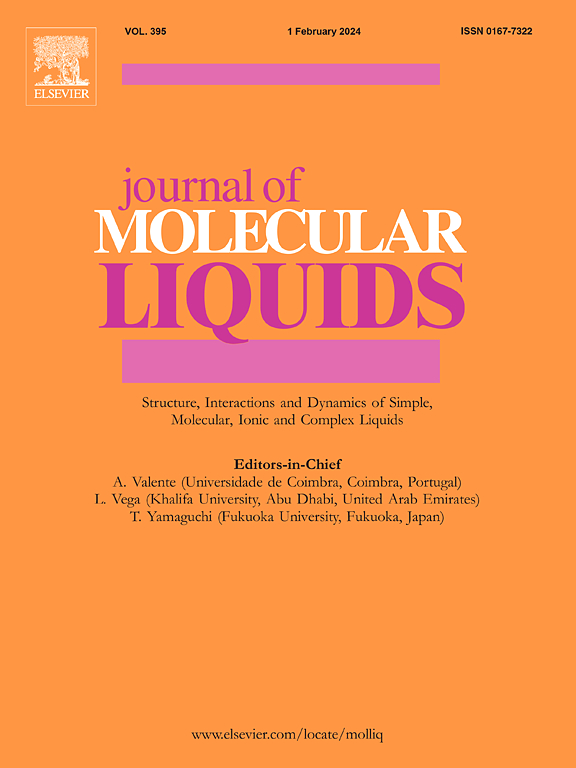gemini表面活性剂-膨润土杂化材料去除废水中的酸性橙-7和环丙沙星
IF 5.3
2区 化学
Q2 CHEMISTRY, PHYSICAL
引用次数: 0
摘要
采用双表面活性剂(丁烷-1,4-双(十六烷基二甲基铵)二溴)g(16-4-16)与膨润土(Bt)粘土插接制备了g(16-4-16)-Bt杂化材料,用于去除废水中的酸性橙-7 (AO-7)和环丙沙星(CPX)。批量吸附条件为:298 K, pH为3 (AO-7)和6 (CPX), AO-7/CPX浓度= 10 mg L−1,吸附剂剂量= 2 g L−1,平衡时间= 60 min (AO-7)和120 min (CPX)。g(16-4-16)-Bt杂化材料对AO-7和CPX的去除率分别为≈98%和95.8%。随着污染物浓度的增加(1 ~ 25 mg L−1),g(16-4-16)-Bt的吸附量显著增加(AO-7的吸附量从0.57增加到12.07 mg g−1,CPX的吸附量从0.57增加到11.43 mg g−1)。在Mg2+, Ca2+, EDTA,碳酸氢盐,硫酸盐和甘氨酸等共存离子存在的情况下进行了吸附研究。发现Mg2+和Ca2+阳离子存在对CPX的去除影响最小,对AO-7的去除影响很小。吸附现象符合拟二级动力学,符合Langmuir等温线。g(16-4-16)-Bt杂化材料对AO-7和CPX的最大吸附量分别为37.08和15.77 mg g−1。即使在第5次吸附-解吸循环后,g(16-4-16)-Bt杂化材料在两种情况下的去除率均保持在75%以上。进行了计算研究,并与实验结果进行了比较,结果吻合较好。g(16-4-16)−Bt可有效去除废水中的AO-7和CPX污染物,表明其具有成本效益和可持续发展的潜力,有助于环境保护。本文章由计算机程序翻译,如有差异,请以英文原文为准。
Removal of acid orange-7 and ciprofloxacin from wastewater using a gemini surfactant-bentonite hybrid material
The g(16-4-16)-Bt hybrid material, prepared by intercalation of a gemini surfactant (butane-1,4-bis(hexadecyldimethylammonium) dibromide), g(16-4-16), with bentonite (Bt) clay, was used for the removal of acid orange-7 (AO-7) and ciprofloxacin (CPX) from wastewater. The batch sorption study suggested optimized conditions for the sorption at 298 K as pH 3 (AO-7) and 6 (CPX), AO-7/CPX concentrations = 10 mg L−1, adsorbent dose = 2 g L−1, equilibrium time = 60 min. (AO-7) and 120 min. (CPX). The g(16-4-16)-Bt hybrid material exhibited a removal efficacy of ≈ 98 % and 95.8 % towards AO-7 and CPX. With the rise in pollutant concentration (1–25 mg L−1), the sorption capacity of g(16-4-16)-Bt showed a notable increase (from 0.57 to 12.07 mg g−1 for AO-7 and 0.57 to 11.43 mg g−1 for CPX). The sorption studies were explored in the presence of co-existing ions such as Mg2+, Ca2+, EDTA, bicarbonate, sulphate, and glycine. The removal of CPX was found to be minimally affected in the presence of Mg2+ and Ca2+ cations, and only a slight impact was found on the removal of AO-7. The sorption phenomenon followed the pseudo-second-order kinetics and showed agreement with the Langmuir isotherm. The maximum sorption capacity of g(16-4-16)-Bt hybrid material towards AO-7 and CPX was found to be 37.08 and 15.77 mg g−1, respectively. Even after the fifth sorption-desorption cycle, the g(16-4-16)-Bt hybrid material sustained more than 75 % removal efficiency in both cases. Computational studies were carried out and compared with the experimental results, which showed a good agreement. The g(16-4-16)−Bt was found to be effective for the removal of AO-7 and CPX pollutants from wastewater, demonstrating its potential as a cost-effective and sustainable approach, which may help in environmental protection.
求助全文
通过发布文献求助,成功后即可免费获取论文全文。
去求助
来源期刊

Journal of Molecular Liquids
化学-物理:原子、分子和化学物理
CiteScore
10.30
自引率
16.70%
发文量
2597
审稿时长
78 days
期刊介绍:
The journal includes papers in the following areas:
– Simple organic liquids and mixtures
– Ionic liquids
– Surfactant solutions (including micelles and vesicles) and liquid interfaces
– Colloidal solutions and nanoparticles
– Thermotropic and lyotropic liquid crystals
– Ferrofluids
– Water, aqueous solutions and other hydrogen-bonded liquids
– Lubricants, polymer solutions and melts
– Molten metals and salts
– Phase transitions and critical phenomena in liquids and confined fluids
– Self assembly in complex liquids.– Biomolecules in solution
The emphasis is on the molecular (or microscopic) understanding of particular liquids or liquid systems, especially concerning structure, dynamics and intermolecular forces. The experimental techniques used may include:
– Conventional spectroscopy (mid-IR and far-IR, Raman, NMR, etc.)
– Non-linear optics and time resolved spectroscopy (psec, fsec, asec, ISRS, etc.)
– Light scattering (Rayleigh, Brillouin, PCS, etc.)
– Dielectric relaxation
– X-ray and neutron scattering and diffraction.
Experimental studies, computer simulations (MD or MC) and analytical theory will be considered for publication; papers just reporting experimental results that do not contribute to the understanding of the fundamentals of molecular and ionic liquids will not be accepted. Only papers of a non-routine nature and advancing the field will be considered for publication.
 求助内容:
求助内容: 应助结果提醒方式:
应助结果提醒方式:


